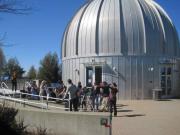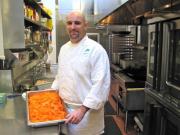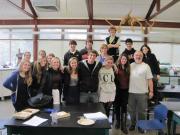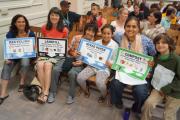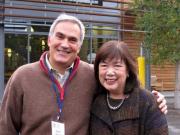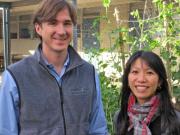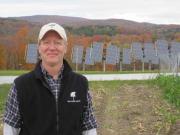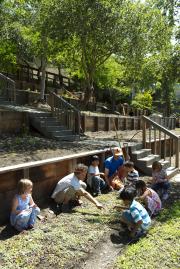Green Schools: Mid-Winter Explorations
In February and March I visited a number of schools, colleges and organizations around the country in Maryland, Virginia and California. Here are their stories about environmental sustainability. The reports are presented in the order visited: Bryn Mawr School, Baltimore, MD; Maryland Association for Environmental and Outdoor Education MAEOE; Collegiate School, Richmond, VA; San Francisco Friends School, CA; Athenian School, CA; Saint Mark's School, VA.
1. Bryn Mawr School: Growing Organically
Over the long history since its founding in 1885 as a private-independent school for girls on a wooded site bordered by a creek in north Baltimore, Bryn Mawr School has fostered in its mission a “commitment to environmental preservation.” In 1998 the school began a new initiative called “Stewardship 2000: Bryn Mawr School’s Environmental Initiative for the 21st Century” to reinvigorate these efforts.
 And in its recent strategic plan, Vision 2020, the school has again strengthened its commitment, declaring that Bryn Mawr will be “conscientious about reducing its ecological footprint…through its curriculum and extracurricular activities” and strive ”to one day become an internationally recognized ‘green school’.”
And in its recent strategic plan, Vision 2020, the school has again strengthened its commitment, declaring that Bryn Mawr will be “conscientious about reducing its ecological footprint…through its curriculum and extracurricular activities” and strive ”to one day become an internationally recognized ‘green school’.”
In 2000 to galvanize the school’s many initiatives underway or being contemplated, Bryn Mawr Head of School Rebecca Fox created a new position of Environmental Coordinator, and hired a new science teacher, Mary Beth Kircher, to take on part-time responsibility and eventually serve as the chair of the science department.  As she observes, the changes during her tenure have been an “organic process” of “cyclical change” characterized by periods of formal and informal initiatives. As Environmental Coordinator, Kircher has a broad mandate: supervising a highly-developed recycling program, maintaining outdoor teaching areas in the school’s garden and Northwoods Project to restore the creek watershed, ensuring the school’s certification as a Maryland Green School, organizing participation in the Green Schools Alliance Green Cup Challenge, and serving as “an advocate for greater environmental awareness in both the curriculum and the campus physical functioning.”
As she observes, the changes during her tenure have been an “organic process” of “cyclical change” characterized by periods of formal and informal initiatives. As Environmental Coordinator, Kircher has a broad mandate: supervising a highly-developed recycling program, maintaining outdoor teaching areas in the school’s garden and Northwoods Project to restore the creek watershed, ensuring the school’s certification as a Maryland Green School, organizing participation in the Green Schools Alliance Green Cup Challenge, and serving as “an advocate for greater environmental awareness in both the curriculum and the campus physical functioning.”
In an early expression of its desire to incorporate green building practices, the school constructed in 1997 a new Admission Cottage in the heart of the campus to serve as a “symbol of the school’s commitment to environmental sustainability.” The handsome, shingled structure features many recycled materials including wood from trees on campus and counter tops made from recycled junk mail, passive solar technology, a rainwater collection system, and photovoltaic panels.  In recent years Kircher herself has had a chance to work on the campus master plan partnering with Project Manager Matt Mitchell, a trained architect and member of the Bryn Mawr administration who coordinates various building activities. The first significant project he took on was a comprehensive renovation of the entire Lower School complex designed in 1972 by the internationally renowned architect Marcel Breuer.
In recent years Kircher herself has had a chance to work on the campus master plan partnering with Project Manager Matt Mitchell, a trained architect and member of the Bryn Mawr administration who coordinates various building activities. The first significant project he took on was a comprehensive renovation of the entire Lower School complex designed in 1972 by the internationally renowned architect Marcel Breuer.  The architects described the commitment to environmental stewardship in the project, especially “the crucial decision to renovate, rather than to build entirely new structures” as well as a host of green practices, from landscaping and rainwater treatment to heat-reflective roofing and efficient HVAC systems.Mitchell is currently conducting an analysis of the school’s HVAC systems in an effort to achieve new efficiencies. More recently Mitchell teamed with Kircher to revamp the school’s recycling and composting program that now saves an estimated $8,000 a year.
The architects described the commitment to environmental stewardship in the project, especially “the crucial decision to renovate, rather than to build entirely new structures” as well as a host of green practices, from landscaping and rainwater treatment to heat-reflective roofing and efficient HVAC systems.Mitchell is currently conducting an analysis of the school’s HVAC systems in an effort to achieve new efficiencies. More recently Mitchell teamed with Kircher to revamp the school’s recycling and composting program that now saves an estimated $8,000 a year.
Looking to the future, Kircher sees many opportunities for Bryn Mawr to continue its environmental work. She is contemplating using the school’s new Rubicon curriculum mapping technology to map the environmental theme in the academic program. At the moment there are various projects in each of the three divisions that promote ecological literacy, including the high school’s A.P. Environmental Science course. And she hopes the food program can continue to incorporate cuisine that is locally grown. With a strategic vision, leadership and a multifaceted approach, Bryn Mawr is becoming more environmentally sustainable, in an organic process well suited to the school and its long history of commitment.
At the moment there are various projects in each of the three divisions that promote ecological literacy, including the high school’s A.P. Environmental Science course. And she hopes the food program can continue to incorporate cuisine that is locally grown. With a strategic vision, leadership and a multifaceted approach, Bryn Mawr is becoming more environmentally sustainable, in an organic process well suited to the school and its long history of commitment.
2. MAEOE: Green from the Top
On Earth Day 2010 PBS screened a documentary called “Growing Greener Schools” that featured the visionary environmental work in Maryland nurtured by the Maryland Association for Outdoor and Environmental Education (MAEOE) in partnership with the state’s political leadership. Drawn together by a common appreciation for the natural beauty of the Chesapeake Bay watershed and the challenges it faces, a coalition of environmental educators and government officials has forged a movement that serves as a model for other states and what they can achieve.  As the Executive Director of MAEOE Bronwyn Mitchell commented on my recent visit, in Maryland the “grassroots has met the political leadership and now we are experiencing exponential change; the foot is on the pedal!”
As the Executive Director of MAEOE Bronwyn Mitchell commented on my recent visit, in Maryland the “grassroots has met the political leadership and now we are experiencing exponential change; the foot is on the pedal!”
Sparked by the book Last Child in the Woods: Saving Our Children From Nature-Deficit Disorder written by Richard Louv in 2005, the Maryland Department of Natural Resources and State Department of Education linked up to strengthen environmental initiatives in the states. In 2008 Maryland Representative John Sarbanes introduced legislation along with Senator Jack Reed (RI) in the US Congress to provide federal funding to support outdoor learning activities and high-quality environmental education for states that have an approved Environmental Literacy Plan. A national coalition called No Child Left Inside quickly emerged to support this legislation. Maryland’s Governor Martin O'Malley established by executive order in April 2008 the Maryland Partnership for Children in Nature to galvanize the state’s environmental education efforts.
Within a year, the 15-member Partnership that was co-chaired by the Head of the Department of Natural Resources and the State School Superintendent produced a report that argues “connecting children to nature and ensuring environmental literacy will best be accomplished through a comprehensive, multi-faceted approach involving both unstructured and structured experiences for children.” The report contains ten recommendations in three broad areas: connecting families and communities to nature, providing access to underserved communities, and “strengthening students’ connection to nature during the school day.” The recommendations include: provide a meaningful watershed educational experience annually for each student, include an environmental literacy course for high school graduation, “establish a comprehensive initiative to green all schools,” and provide professional development for teachers and other environmental educators. In addition recommended the adoption of an Outdoor Bill of Rights modeled after California’s, a statewide environmental education campaign directed toward adults, and annual Children in Nature Summits to celebrate accomplishments. (Maryland Partnership for Children in Nature Report, April 2009).
MAEOE played a vital role in shaping the report and is now helping to lead its rapid implementation.  Founded in 1985, its mission is to help “encourage, educate, support and inspire Maryland educators to build a citizenry that understands and is responsibly engaged in advancing sustainability…” and offers a variety of resources and professional development programs to accomplish their vision. Bronwyn Mitchell brought her experience as a Peace Corps volunteer in Botswana’s Okavango Delta and as a wetlands environmentalist in American Samoa when she joined MAEOE just two years ago. Among her organization’s notable programs is one of the nation’s largest, annual professional conferences for environmental educators that draws over 600 people.
Founded in 1985, its mission is to help “encourage, educate, support and inspire Maryland educators to build a citizenry that understands and is responsibly engaged in advancing sustainability…” and offers a variety of resources and professional development programs to accomplish their vision. Bronwyn Mitchell brought her experience as a Peace Corps volunteer in Botswana’s Okavango Delta and as a wetlands environmentalist in American Samoa when she joined MAEOE just two years ago. Among her organization’s notable programs is one of the nation’s largest, annual professional conferences for environmental educators that draws over 600 people.
MAEOE’s Green Schools Program, headed by Mitchell’s colleague Joanne Schmader, demonstrates how a recognition program can inspire educators to embrace environmental education. Founded in 1999, the program has certified some 340 schools out of the 2000 that serve the state’s one million students. All public and private schools in the state may submit an application that covers three areas: Curriculum and Instruction, including the environmental component of the academic program and professional development; Best Management Practices, including a focus on water, energy, waste, habitat, transportation, and a healthy school environment; and Community Partnerships. Schools are certified for a two-year period.
Maryland’s integrated, collaborative approach to promoting environmental education stems from a strong sense of place for those living in the state that is in heart of the Chesapeake Bay watershed. The alliance that has been forged between the state’s political and governmental leadership, schools, and non-formal environmental educators is remarkable. Others would be well advised to study the Maryland example closely.
3. Collegiate School: Green from the Ground Up
On a brisk, beautiful early March day in Richmond following an epic rainstorm that left the Virginia air clear and the skies blue, Lower School art teacher Holly Smith warmly welcomed me to the Collegiate School with a broad smile, and a carefully orchestrated plan to show me all the school is doing to embrace environmental sustainability.  Long attracted to the natural world, she attended the NAIS Leadership in Sustainability Institute in 2006, and since then she has been “trying to inspire and implement environmental consciousness at Collegiate School.” She was proud to show me “what can be done in a large K-12 (1575 enrollment) school with a bottom-up approach to becoming a ‘greener school’.”
Long attracted to the natural world, she attended the NAIS Leadership in Sustainability Institute in 2006, and since then she has been “trying to inspire and implement environmental consciousness at Collegiate School.” She was proud to show me “what can be done in a large K-12 (1575 enrollment) school with a bottom-up approach to becoming a ‘greener school’.”
Naturally, a first focus for her work was the Lower School itself and the new garden, a “crown jewel that we love.”  Chatting with the “garden guru” Ellen Clore and a group of parent volunteers, I saw a facility carefully designed as a teaching garden that has been certified as a wildlife habitat by the National Wildlife Foundation, with plants selected to incorporate the native plants of Virginia and a program that allows students to raise vegetables, monitor the official “monarch way station,” study nesting bluebirds through the “bird cam,” and practice composting.
Chatting with the “garden guru” Ellen Clore and a group of parent volunteers, I saw a facility carefully designed as a teaching garden that has been certified as a wildlife habitat by the National Wildlife Foundation, with plants selected to incorporate the native plants of Virginia and a program that allows students to raise vegetables, monitor the official “monarch way station,” study nesting bluebirds through the “bird cam,” and practice composting.  And in Holly’s classes young artists are trained to observe and sketch in the outdoors. The school is beginning to incorporate more environmental themes in the curriculum, supported by a handsome, in-house botanical garden for Middle School, a Grade 9 required Chemistry in the Community course focused on real-world issues, and new Grade 12 electives like A.P. Environmental Science being developed by faculty member Kelly Tracy.
And in Holly’s classes young artists are trained to observe and sketch in the outdoors. The school is beginning to incorporate more environmental themes in the curriculum, supported by a handsome, in-house botanical garden for Middle School, a Grade 9 required Chemistry in the Community course focused on real-world issues, and new Grade 12 electives like A.P. Environmental Science being developed by faculty member Kelly Tracy.
The 55-acre campus on Moreland Avenue has incorporated many sustainable features, initially with the visionary leadership of now-retired CFO Bob Sedivy, and now with Facilities Director Scott Carson and Head of School Keith Evans.  Taking a “practical approach” to their initiatives, they installed one of Virginia’s first synthetic turf fields, re-lamped the campus with T-8 fluorescents, replaced low-E glass, put in a Filterra storm water treatment system in the parking lot, used recycled oak trees for a pedestrian bridge across the creek, and incorporated draught tolerant plantings. They encouraged the Housekeeping Supervisor Bill Skinner, whose team is responsible for 26 buildings, “to do new things,” and he set out to eliminate caustic chemicals and has adopted a new ec-H2O “electrically converted water system” that reduces water use and the need for detergents.
Taking a “practical approach” to their initiatives, they installed one of Virginia’s first synthetic turf fields, re-lamped the campus with T-8 fluorescents, replaced low-E glass, put in a Filterra storm water treatment system in the parking lot, used recycled oak trees for a pedestrian bridge across the creek, and incorporated draught tolerant plantings. They encouraged the Housekeeping Supervisor Bill Skinner, whose team is responsible for 26 buildings, “to do new things,” and he set out to eliminate caustic chemicals and has adopted a new ec-H2O “electrically converted water system” that reduces water use and the need for detergents.  Anticipating the construction of 50,000 square feet of new buildings, they are considering a solar energy system through a power-purchase agreement, and LEED certification for their new buildings, which at one time appeared to add too much expense but now looks as if it could have cost saving potential.
Anticipating the construction of 50,000 square feet of new buildings, they are considering a solar energy system through a power-purchase agreement, and LEED certification for their new buildings, which at one time appeared to add too much expense but now looks as if it could have cost saving potential.
Collegiate is pioneering in several initiatives that promise to position the school for further leadership.  In 1999 the school acquired a parcel of 154 acres several miles to the west, and they have developed the property into the stunning Robins Campus athletic complex, which features synthetic turfed fields, a rainwater run-off irrigation pond, and careful efforts to recycle sod and compost. This fall the school is building on its strong global education program by offering a conference for 50 “International Emerging Leaders: The Global Economy and the Environment.”
In 1999 the school acquired a parcel of 154 acres several miles to the west, and they have developed the property into the stunning Robins Campus athletic complex, which features synthetic turfed fields, a rainwater run-off irrigation pond, and careful efforts to recycle sod and compost. This fall the school is building on its strong global education program by offering a conference for 50 “International Emerging Leaders: The Global Economy and the Environment.”
In my view, Collegiate School illustrates that when environmental sustainability proceeds from “the bottom up” by encouraging the leadership of faculty like Holly Smith, and “from the top” for institutional initiatives, the progress can be remarkable.
4. San Francisco Friends School: From Jeans to Green
When San Francisco Friends School was founded in 2002 as a K-8 coeducational independent school it promised to offer “outstanding academics with Quaker values of simplicity, integrity, mutual respect, and peaceful problem-solving.” The search for a permanent home for the school enabled SF Friends to express these values in a bold venture in “environmental stewardship” when they acquired the Levis Strauss building at 250 Valencia.  By re-using and preserving the 100 year old factory that was the original “home of blue jeans,” the school created a beautiful facility as they declared, “our commitment to environmental responsibility has deep roots in Quaker values.”
By re-using and preserving the 100 year old factory that was the original “home of blue jeans,” the school created a beautiful facility as they declared, “our commitment to environmental responsibility has deep roots in Quaker values.”
Visiting the school recently in March as a current member of the Board of Trustees, I found the school living those values as it deepens its commitment to environmental sustainability.  Director of Finance and Operations Paul Galvin showed me the remarkable green features of the building that include a passive ventilation system using thermal towers, the original working windows, hydronic in-floor water heating, restored heavy timber beams and original maple flooring, and a playground made from recycled materials. Focusing on the actual operations, as a city school SF Friends vigorously promotes alternate transportation to its location in the Mission District, by bus, BART, carpool, bike and special “walk-to-school’ days and encourages the use of Muni and BART for field trips. A well-subscribed parent wiki provides an electronic forum to exchange important school information that saves a great deal of paper. Currently, they are evaluating with the City of San Francisco Renewable Energy Division the addition of a solar energy system, originally thought to be too expensive.
Director of Finance and Operations Paul Galvin showed me the remarkable green features of the building that include a passive ventilation system using thermal towers, the original working windows, hydronic in-floor water heating, restored heavy timber beams and original maple flooring, and a playground made from recycled materials. Focusing on the actual operations, as a city school SF Friends vigorously promotes alternate transportation to its location in the Mission District, by bus, BART, carpool, bike and special “walk-to-school’ days and encourages the use of Muni and BART for field trips. A well-subscribed parent wiki provides an electronic forum to exchange important school information that saves a great deal of paper. Currently, they are evaluating with the City of San Francisco Renewable Energy Division the addition of a solar energy system, originally thought to be too expensive.
San Francisco Friends is now turning its attention to other dimensions of what it means to be an environmentally sustainable school. As Academic Dean Gwen Rino explained, “our Quaker orientation to the world compels us to think in a particular way about how we walk on the earth, and the implications for others.” She discovered a love of the outdoors camping and hiking in the Sierras and after ten years at Prospect Sierra School, she joined SF Friends to lead program development, recently launching an effort to map the curriculum.  She has identified environmental lessons in virtually every grade level, including primary grade art projects, a study of recycling at the school by first graders investigation teams, upper elementary students study of ecosystems and Middle School science lessons on water usage and the carbon cycle that are linked to California state standards.
She has identified environmental lessons in virtually every grade level, including primary grade art projects, a study of recycling at the school by first graders investigation teams, upper elementary students study of ecosystems and Middle School science lessons on water usage and the carbon cycle that are linked to California state standards.
In parallel fashion, Assistant Head Guybe Slangen  has developed the school’s service learning program as part of the Quaker commitment to community and to “engage with the larger world around us.” He too described a K-8 curriculum that has first graders analyzing the school’s composting program, second graders mapping storm drains in the Mission District through the Watershed Project, fourth graders studying ocean health with the Surf Riders Project, and sixth graders studying how gardens build community with the Seed Folks. In addition the school’s trips program that has a service component, takes students on local forays to Tilden Park and Lake Lagunitas and beyond to Joshua Tree and Nicaragua. With so many initiatives developed by individual faculty members, the school seems well positioned to engage in a deeper study of the environmental theme in the curriculum.
has developed the school’s service learning program as part of the Quaker commitment to community and to “engage with the larger world around us.” He too described a K-8 curriculum that has first graders analyzing the school’s composting program, second graders mapping storm drains in the Mission District through the Watershed Project, fourth graders studying ocean health with the Surf Riders Project, and sixth graders studying how gardens build community with the Seed Folks. In addition the school’s trips program that has a service component, takes students on local forays to Tilden Park and Lake Lagunitas and beyond to Joshua Tree and Nicaragua. With so many initiatives developed by individual faculty members, the school seems well positioned to engage in a deeper study of the environmental theme in the curriculum.
The school’s environmental initiatives receive a strong boost from a group of motivated and talented parents. Co-clerks of the Eco-Friends Committee,  Maryam Mohit and Laurel Skurko-Kao have pioneered various initiatives including a bike and walk-to-school effort and a commitment to reduce, reuse and recycle that features a regular web-based swap program for children’s, sports and women’s clothes. Each has been motivated by a profound sense that with the challenges of climate change, we cannot afford to “fiddle while Rome burns.” In the future they hope to focus on the challenge of providing healthy food in a school that has no central kitchen.
Maryam Mohit and Laurel Skurko-Kao have pioneered various initiatives including a bike and walk-to-school effort and a commitment to reduce, reuse and recycle that features a regular web-based swap program for children’s, sports and women’s clothes. Each has been motivated by a profound sense that with the challenges of climate change, we cannot afford to “fiddle while Rome burns.” In the future they hope to focus on the challenge of providing healthy food in a school that has no central kitchen.
 The environmental spirit at San Francisco Friend School clearly stems from the core Quaker values of simplicity, service and commitment to community. And the confidence to move forward has been nurtured by the effervescent, founding Head of School, Cathy Hunter. When the Parents Association asked for permission to expand their environmental initiatives, she responded with enthusiastic encouragement: “Just go for it!”
The environmental spirit at San Francisco Friend School clearly stems from the core Quaker values of simplicity, service and commitment to community. And the confidence to move forward has been nurtured by the effervescent, founding Head of School, Cathy Hunter. When the Parents Association asked for permission to expand their environmental initiatives, she responded with enthusiastic encouragement: “Just go for it!”
5. Athenian School: Sun-Powered Environmentalism
Driving onto the 75-acre campus of the Athenian School, a 6-12 day-boarding school of 460 students set at the foot of Mt. Diablo in Danville, CA,  the school’s commitment to environmental sustainability is visible for miles around: perched on a hillside in the form of a large “A” is a 1300 panel, 350,000kw solar array that generates 60% of the schools energy needs.
the school’s commitment to environmental sustainability is visible for miles around: perched on a hillside in the form of a large “A” is a 1300 panel, 350,000kw solar array that generates 60% of the schools energy needs. Recently recognized for significant environmental leadership, Athenian has since its founding in 1965 embraced a commitment to sustainability in the school’s mission. Athenian seeks to “instill an appreciation of the reciprocal relationship…between society and the natural world and stewardship of the environment.”
Recently recognized for significant environmental leadership, Athenian has since its founding in 1965 embraced a commitment to sustainability in the school’s mission. Athenian seeks to “instill an appreciation of the reciprocal relationship…between society and the natural world and stewardship of the environment.”
One of the leaders of the school’s most recent drive for energy and operational efficiency, Bob Oxenburgh, Director of Finance and Facilities, described his “curmudgeonly approach,” telling me that when he came to the school in 2005 he was driven to look for ways to save the school money. Trained as a chemical engineer in England and retired from a banking career, he estimated he could produce significant costs savings from operations that could be used to support the school’s educational mission. In a presentation I first encountered at the Green Schools Alliance in Ojai, he outlined the environmental strategies Athenian has used to save money. In addition to the hillside solar array that was installed through a power-purchase agreement, the school installed a solar array to heat the pool that cut natural gas expenses, reduced trash off-haul costs through recycling and a heavy-duty Earth Tub composting system, reduced water costs by stopping winter irrigation and by installing an artificial turf athletic field that saves $20,000 a year in maintenance and will pay for itself in a decade. Contrary to contemporary wisdom, Oxenburgh shows that it is “easy to be green” and that it saves money.
Trained as a chemical engineer in England and retired from a banking career, he estimated he could produce significant costs savings from operations that could be used to support the school’s educational mission. In a presentation I first encountered at the Green Schools Alliance in Ojai, he outlined the environmental strategies Athenian has used to save money. In addition to the hillside solar array that was installed through a power-purchase agreement, the school installed a solar array to heat the pool that cut natural gas expenses, reduced trash off-haul costs through recycling and a heavy-duty Earth Tub composting system, reduced water costs by stopping winter irrigation and by installing an artificial turf athletic field that saves $20,000 a year in maintenance and will pay for itself in a decade. Contrary to contemporary wisdom, Oxenburgh shows that it is “easy to be green” and that it saves money.
The school’s Environmental Steward, Spanish teacher John Harvey, has brought his own creative approach promoting environmental sustainability in the program. Working with his colleagues, Science Department Chair Dave Otten and science teacher Ray Engeszer, they have shaped the academic program to include a Grade 9 science course that includes work in the school’s organic garden, composting system and bio-diesel production. The school’s Conservation Club has helped to develop a permaculture garden and this year created a bioswale to prevent erosion on a campus hillside.  In the food operation run by Sodexo students regularly take shifts in the kitchen composting initiative.
In the food operation run by Sodexo students regularly take shifts in the kitchen composting initiative.  And through the school’s commitment to outdoor and wilderness education and membership in the Round Square program students regularly have a memorable experience in nature. According to Harvey, the school is preparing to focus on integrating environmental sustainability throughout the curriculum.
And through the school’s commitment to outdoor and wilderness education and membership in the Round Square program students regularly have a memorable experience in nature. According to Harvey, the school is preparing to focus on integrating environmental sustainability throughout the curriculum.
School Head Eric Niles, who believes that environmental sustainability is “the right thing to do,” is justifiably proud of the recognition his school has received for its leadership.  In the last several years, Athenian has been recognized as a Green Power Partner by the Environmental Protection Agency, received a Waste Reduction Award (WRAP) from the California Department of Resources, Recycling and Recovery), used a grant from the Alliance for Climate education to implement green programs like converting a car from gas to electric power, and won the Sustainable Contra Costa School of the Year award in 2010. Niles points to the power of the school’s strategic plan that has driven much change at the school. Athenian clearly deserves to be in the spotlight for its sun-drenched environmentalism.
In the last several years, Athenian has been recognized as a Green Power Partner by the Environmental Protection Agency, received a Waste Reduction Award (WRAP) from the California Department of Resources, Recycling and Recovery), used a grant from the Alliance for Climate education to implement green programs like converting a car from gas to electric power, and won the Sustainable Contra Costa School of the Year award in 2010. Niles points to the power of the school’s strategic plan that has driven much change at the school. Athenian clearly deserves to be in the spotlight for its sun-drenched environmentalism.
6. Saint Mark’s School: Strategic Sustainability
In the relatively short time since its founding in 1980 as a K-8 independent school for 380 students in San Raphael, Saint Mark’s school has regularly used a formal strategic planning process to chart, and to redirect, its course.  In the fall of 2008, amidst global financial instability, the school boldly looked again to its future, this time using as an organizing principle "six dimensions of sustainability." Adapted from the National Association of Independent Schools “with a specific Saint Mark’s perspective,” the themes include programmatic, global, environmental, demographic, cultural, and financial sustainability.
In the fall of 2008, amidst global financial instability, the school boldly looked again to its future, this time using as an organizing principle "six dimensions of sustainability." Adapted from the National Association of Independent Schools “with a specific Saint Mark’s perspective,” the themes include programmatic, global, environmental, demographic, cultural, and financial sustainability.
An important new direction for Saint Mark’s is environmental sustainability. Based on the school’s educational philosophy to “teach, learn, and live in a sustainable way” and a desire to “prepare Saint Mark's students to become effective stewards of the planet,” the Strategic Plan is stimulating significant change at the school.  The plan was guided by the school’s long-term Head of School Damon Kerby, who joined Saint Mark’s in 1987 after eight years teaching history at the nearby Branson School. As he notes, “We are uniquely situated as school heads to lead communities in moral ways, and environmental sustainability is for me a moral issue. We need to help our students develop a world view that is better than our generation’s.”
The plan was guided by the school’s long-term Head of School Damon Kerby, who joined Saint Mark’s in 1987 after eight years teaching history at the nearby Branson School. As he notes, “We are uniquely situated as school heads to lead communities in moral ways, and environmental sustainability is for me a moral issue. We need to help our students develop a world view that is better than our generation’s.”
The Strategic Plan itself declares that “an integrated green curriculum and a green campus will develop empowered citizens ready to affect their world and able to use sustainability practices in their personal lives.”  The plan’s goal to “implement environmental sustainability as a core value in all levels of the school community and its activities” is to be implemented through five objectives: a K-8 sustainability curriculum integrated in the current academic program, a campus master plan that “strives for the highest level of sustainability possible, a reduced carbon footprint, sustainability leadership, and outreach to the community.
The plan’s goal to “implement environmental sustainability as a core value in all levels of the school community and its activities” is to be implemented through five objectives: a K-8 sustainability curriculum integrated in the current academic program, a campus master plan that “strives for the highest level of sustainability possible, a reduced carbon footprint, sustainability leadership, and outreach to the community.
So how has the plan impacted the school? In a recent report submitted to the California Association of Independent Schools, the school responded to a recommendation from the visiting accreditation team from 2008 “that the administration and faculty study sustainability in order to formally and informally integrate it into the curriculum.” The school feels this recommendation has been addressed “very successfully.” Significantly, the school appointed long-term Grade 7/8 science teacher Diane Bredt as the Sustainability Coordinator.  Under her leadership the Upper School science students have engaged in a series of campus-wide audits of electricity, water and trash, and have prepared recommendations for improvements, most of which have been successfully implemented. As she says, “I like teaching science because it is fun, it gives my students hands-on, real world problem solving experience.” The students now have a Green Team club, and they have adopted the cooltheearth.org program for K-8 schools that asks students to engage their families in adopting more environmentally friendly practices at home. Parent volunteers have created a butterfly garden in the center of campus and a beautiful and very well used organic garden for student study and service.
Under her leadership the Upper School science students have engaged in a series of campus-wide audits of electricity, water and trash, and have prepared recommendations for improvements, most of which have been successfully implemented. As she says, “I like teaching science because it is fun, it gives my students hands-on, real world problem solving experience.” The students now have a Green Team club, and they have adopted the cooltheearth.org program for K-8 schools that asks students to engage their families in adopting more environmentally friendly practices at home. Parent volunteers have created a butterfly garden in the center of campus and a beautiful and very well used organic garden for student study and service.  The school has hired a part-time garden coordinator who works with students, teachers and parent volunteers in the organic garden. And just last year the school held its first annual Eco-Fest that gave students a chance to participate in an afternoon of workshops about ecological topics.
The school has hired a part-time garden coordinator who works with students, teachers and parent volunteers in the organic garden. And just last year the school held its first annual Eco-Fest that gave students a chance to participate in an afternoon of workshops about ecological topics.
Looking to the future, Saint Mark’s is entering a period of transition and change as Damon Kerby retires and hands the baton to the Academic Dean Joe Harvey from nearby Marin Academy. Diane Bredt hopes that the school will now begin a more formal curriculum development process, beginning with an audit of environmental topics already included in the academic program. With a firm foundation in the Saint Mark’s strategic plans, environmental sustainability appears to be ensured of a prominent role in the school’s future.
